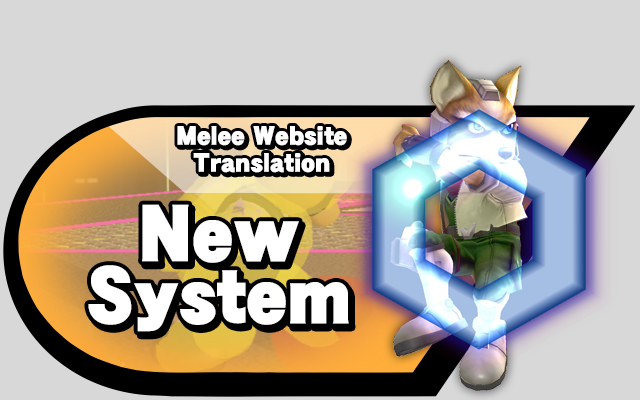This is a translation of New Systems page from News Flash! Smash Bros. Dojo, Melee’s version of the Smash Bros. Dojo.
This time around, we’ll be talking about some pretty specific things.
There are a lot of new systems included in this game.
But, I don’t want to make the controls complicated! Thus, I’ve made it so that most of these things have controls that are easy to pull off without focusing or trying too hard.
I’m a little hesitant to be writing something like this pre-release. It’s possible that this is going to be confusing to the newcomers.
“But Smash Brothers is very easy to play!” is a point that I want to emphasize. There’s no need to use or master all of these techniques.
Uh, wait, how much of these are new systems?
How much did I write on “Smash Dojo”?
Charging Smash attacks

When you use a Smash attack, you can hold the button to charge it and increase its attack power!
It’s not an excessive increase in power, but there is a unique tactic here in that you can change the timings of your attacks.
“Super Smash Bros. Melee” can be played in the same way as the previous game, but I think it’s better if you don’t think of them as the same thing.
Meteor Cancelling


What is this? Meteor Smashes (that is, attacks that send you straight downwards) can now be beaten!
After a certain period of time passes after you get hit by a Meteor Smash, you can double jump or use your Up+B even if you are in hitstun.
Knockdown Damage

This time, when you’ve been knocked down and take a small amount of damage, you wriggle and squirm a little bit while staying prone.
The knockback you receive when in a knockdown state is weaker, and you may be able to act immediately after knockback if you’re hit by a fairly strong move.
However, there’s no merit in staying knocked down, so if you can, you should get up as quick as possible.
Walking while carrying large items, throwing large items up or down

Large items (Boxes, Barrels, etc) are still heavy, but you can walk slowly while carrying them, and they can be thrown upwards or downwards.
Loop Damage

Now, when you’re in the loop (the thing that shows up when you’re outside the boundaries of the screen), you slowly accumulate damage!
You probably shouldn’t wait outside of the screen on stages like Mushroom Kingdom, for example.
Ledge Jump

When you’re grabbing the ledge, if you input a jump, you can perform a ledge jump.
Now you have one more option from the ledge.
Walljump/Triangle Jump

A portion of the cast can perform a walljump by hitting a wall and flicking the stick in the opposite direction. It’s a technique that you can use to gain height without expending your double jump.
Mario and Samus have walljumps in their original games, so they can do it here as well.
Otherwise, characters that are generally considered speedy can do it as well.
Dash Grabs

From here on we’ll discuss new mechanics relating to throws.
If you dash and input a grab, you’ll perform a dash grab.
It’s useful for surprise attacks, but on the other hand, if you miss, your opponent has a larger window to counterattack.
Pummels

When you’ve grabbed an opponent, you can pummel them with the A button.
The damage and knockback on throws has been generally reduced, but that’s because I’ve factored in that you can damage opponents right after a grab, or that you can follow up after a throw.
I don’t want people to get away with the strategy of just repeatedly throwing their opponent, after all.
Escaping Grabs

To counter pummels, you can now escape grabs.
By mashing buttons, you can wriggle free quicker.
How many pummels you can get in before a throw is one element of strategy.
Up-throws and Down-throws

Previously, you could only throw to the left and right, but now you can throw in all four cardinal directions.
Each throw has its own qualities– some are useful for combos, and some are useful for positioning, so it’s crucial that you consider the situation, your opponents percentage, size, weight, and other factors in deciding which throws to use.
You can use the R trigger for throws as well– there are quite a few new systems that use the R trigger.
I’m tired, so see you again in two weeks!
*All systems described are works in progress and there is a chance they may be cut.
Follow Source Gaming on Twitter for more news!
- Sakurai’s Internal Smash for Wii U/3DS Development Notes - June 23, 2017
- Kirby’s Development Secrets - April 19, 2017
- Sakurai Discusses His Game Design Philosophy In a Podcast [2002] - March 28, 2017










wish they’d consider throw teching instead of having to rely on ports.
>tfw no wavedash
“Otherwise, characters that are generally considered speedy can do it as well.”
If he’s kept that same mindset while developing the newer Smash games, it would explain why Little Mac can wall jump.
…Meanwhile, Villager with his fourth-lowest dash speed has a wall jump. >.<
Maybe he changed his mind between Melee and Smash 4 😛